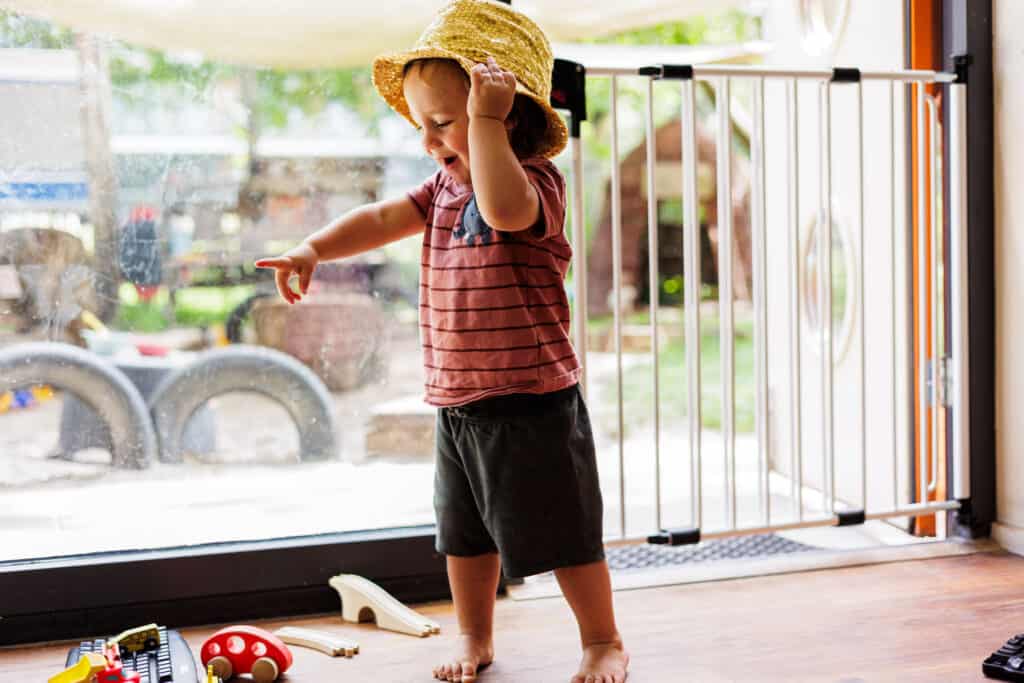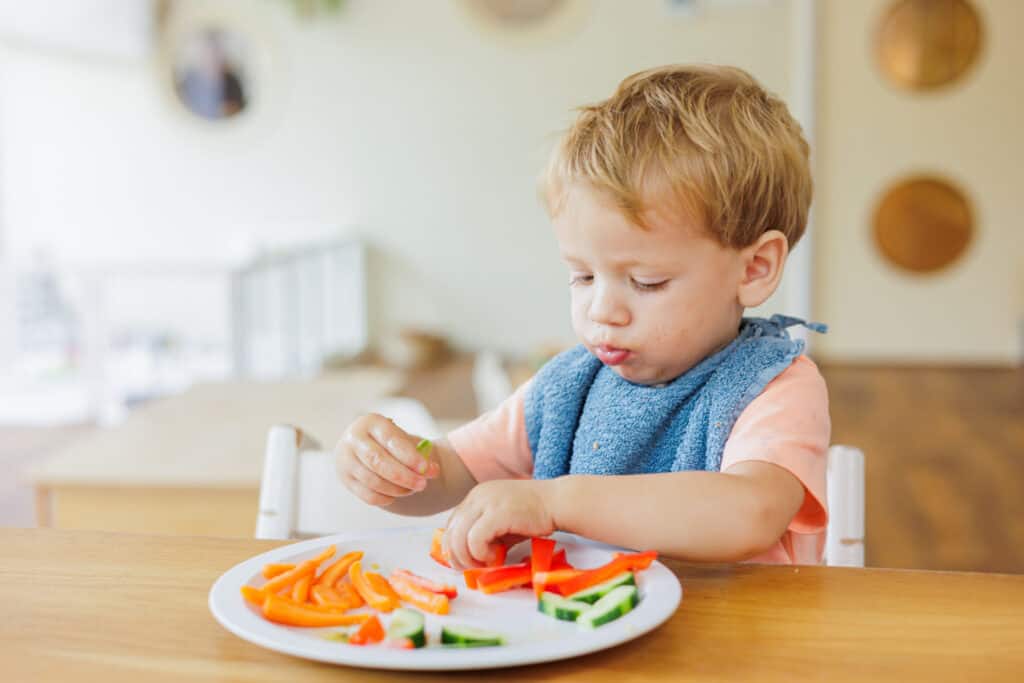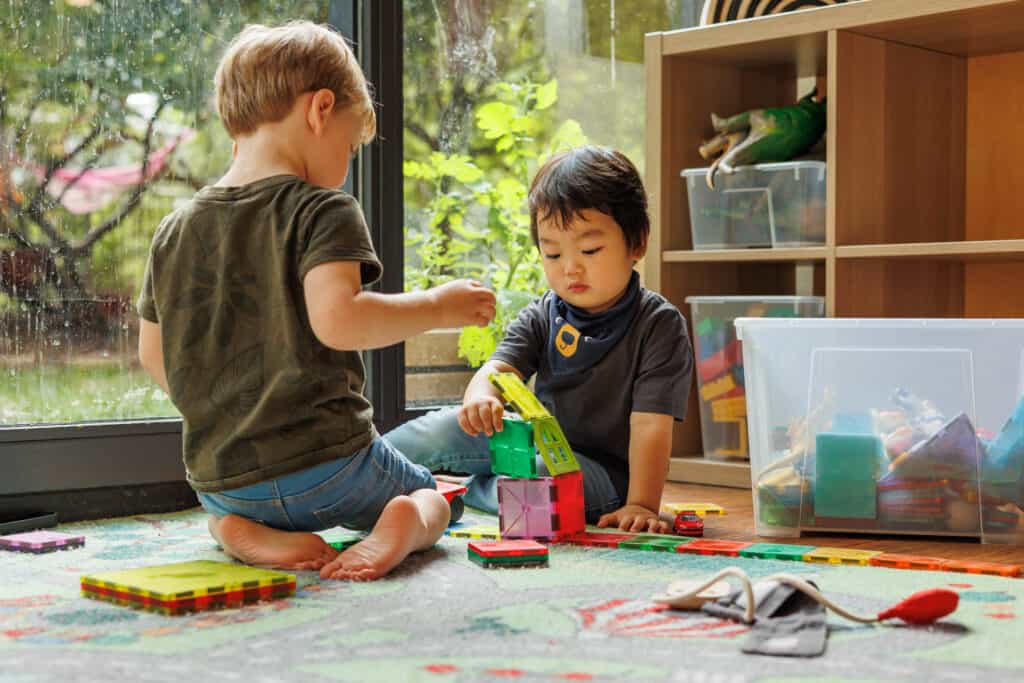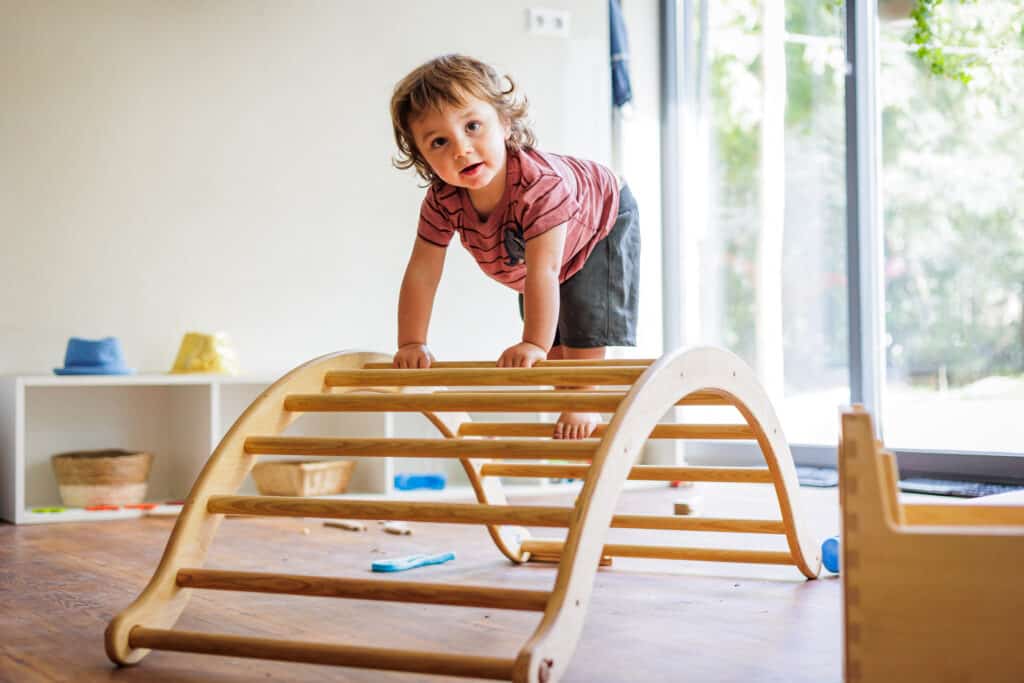Your child is 1,5 – 2,5 years old
The timeline below shows the key milestones in your child’s development during this age. We should like to tell you about the things children experience in each developmental area and, of course, we also want to explain how we respond to this at KinderRijk.
Learn more about…

1. Motor skills
During this age phase, your child’s motor development makes huge strides. Your child learns to walk independently and securely, will climb stairs for the first time with the help of the armrest, and fine motor skills are also becoming increasingly refined. For example, by the end of the second year of life, a toddler will be able to turn the pages of a book one by one and a toddler will also be able to cut paper quite nicely.
Room to move around
We give children all kinds of tasks that develop independence. We let them take the coat by themselves and if they are able to, put it on by themselves. At this age, your child enjoys helping you and their peers. At day care and preschool, they can help fold laundry, take away the food cart and set the table. These are good exercises for gross and fine motor skills and at the same time strengthen the children’s self-confidence.
Around 18 months, your child will be able to run. This is sometimes still a bit clumsy because balance is not yet fully developed.
There is plenty of space for movement both indoors and outdoors. Inside, fine motor skills are encouraged by playing with different kinds of materials. We regularly do toddler dance with the children where they practice their motor skills, sense of rhythm and balance. And outside, we have different kinds of surfaces for your child to have a variety of experiences. For example, jumping in a pile of sand feels very different to jumping on tiles.
We coordinate the start of toilet training with you. Besides the fixed times for going to the bathroom, we also follow the children’s needs. In that way, your child learns to listen to his body better.

Milestones
-
Balance
Your child’s balance and coordination are developing rapidly. This also makes him fall less often.
-
Lugging things around
Your child starts lugging things around and likes to take things with him. He will combine walking with objects. For example, dragging something behind him or pushing it (block cart).
-
Look what I can do!
Your child is becoming increasingly aware of what he is able to do: standing on one leg, jumping, turning in circles. He loves to show you!
-
Toilet training
From around the age of 2, your child will start to let you know that he has a wet nappy.
“WE HAVE DIFFERENT TYPES OF SURFACES OUTSIDE THAT ALLOW YOUR TODDLER TO HAVE A VARIETY OF EXPERIENCES. FOR EXAMPLE, JUMPING IN A PILE OF SAND FEELS VERY DIFFERENT TO JUMPING ON TILES.”


2. Language development
During this age, language development increases very rapidly. Between one and two years, your child starts making sentences of two words, for example: ‘Mummy gone’. Your child understands simple instructions and sentences, such as: ‘Where is the car?’. Your child can also point out body parts on a doll, such as the nose or foot. At this stage, your child starts saying more and more words.
Naming actions
The educational staff talk to the children a lot and name their actions as much as possible. This makes the link between what they say and what they are doing clear to the child. Your child starts to understand more and more and is therefore better able to cooperate to actions. Educational staff ask children to take off their socks by themselves, for example, and they are happy to help.
We read to the children much, ask open-ended questions and explain pictures. This benefits speech development. The educational staff sing a lot with the children, using gestures.
The pace at which children learn language varies greatly. There is also a difference between boys and girls. In general, girls learn to speak earlier than boys.
“THE PACE AT WHICH CHILDREN LEARN LANGUAGE VARIES GREATLY. THERE IS ALSO A DIFFERENCE BETWEEN BOYS AND GIRLS. IN GENERAL, GIRLS LEARN TO SPEAK EARLIER THAN BOYS.”
Milestones
-
First words
Your child starts saying mum and dad. Then he moves from one-word sentences to two-word sentences. Around the age of 2, your child will be using three-word sentences.
-
Use of non-verbal language
Your child is going to point, grab your hand, fetch something or show something to make things clear to you.
-
First name
Your child calls his name when he talks about himself, for example: Dylan eat? This will tell you that Dylan wants to eat.

3. Cognitive development
Your child’s cognitive development includes learning, memorisation, problem solving and intelligence.
At this age, your toddler starts to understand the world better all the time. Today is different from tomorrow, yellow is a different colour from blue… Cognitive development is fuelled by your child’s curiosity. Your adolescent toddler knows that some things are not allowed, but sometimes does them anyway to see how you react to his actions.

Discover and repeat
While your 1.5-year-old child learns mainly through discovery and experience, a child from the age of 2 learns to endlessly try out and repeat what he previously experienced and discovered. Cognitive skills are therefore being developed in a playful way. All day long, children keep on imitating and exploring boundaries of what is and what is not allowed.
We provide plenty toys to enable the children to have a variety of experiences: we have different kinds of puzzles, dolls, animal figures, a kitchenette, DUPLO, wooden blocks. As children at this age also like to collect, we have many of the same toys.
We give your child simple tasks and he is happy when something succeeds because he realises that he has managed to do it by himself, like stacking cups.
Your child learns skills such as waiting, sharing and listening to each other. Although your child will be taking an increasingly greater interest in other children, he still prefers to play alone or play his game side by side with someone else (parallel play).
Milestones
-
Contrast
Your child’s eyes need more contrast to see colours properly. At this age, your child learns to name and distinguish colours. Primary colours are favoured.
-
Memory
Your child knows more and more rhymes and songs by heart with the appropriate gestures. Children love repetition.
-
Puzzles
Your child can make puzzles with different pieces with buttons. From the second year, he can make puzzles with pieces without buttons.
-
Making a choice
From 1.5 years, your child can make choices, e.g. “yes banana, no carrot”.
-
Routine
From the age of two, your child starts to see the logical sequence of events; in the process, he learns a great deal from routines, such as during dressing.
“ALL DAY LONG, CHILDREN KEEP ON IMITATING AND EXPLORING BOUNDARIES OF WHAT IS AND WHAT IS NOT ALLOWED.”


4. Personality development
Children experience that they can create something by themselves. This creates a nascent sense of self. Your child starts experimenting with behaviour and discovers that this affects the situation and the people around him. This includes moments of stubbornness and tantrums.
Coming up with your own solution
Children at this age are still very self-centred. Sharing is difficult for them, they are not yet able to put themselves in another child’s place and empathise. This is why we make sure we have plenty of the same material in the group, and when they fall out about toys, we often let them come up with their own solution first. It’s remarkable how well children are able to do that, which is why we give them room to sort it out by themselves.
We make agreements with your child about eating and sleeping, about the use of toys and, above all, we set examples by living them. By providing a good example, children adopt this behaviour because they like to imitate.
From the age of two, pretend play is a way to play everyday experiences. The children develop their imagination and fantasy. With cloths and dress-up clothes, they experiment with different roles in the doll corner. Children are alternately a fireman, lion, mother or doctor.
“FROM THE AGE OF TWO, PRETEND PLAY IS A WAY TO ABSORB EVERYDAY EXPERIENCES.”
Milestones
-
Egocentricity
Your child puts himself at the centre of everything he does. He is not yet able to consider that another person may have feelings different to his own.
-
Own name
At this age, children start to recognise themselves in a photo and call their own name.
-
Talking
As your toddler starts talking more, his self-awareness increases.


5. Social-emotional development
Much happens during this period in terms of social-emotional development. It’s a period in which they both learn to walk and talk while not yet always understanding what is happening. A great deal is expected of your child while he still needs you as a parent. As he is able to do increasingly more things, he also discovers his own will and he discovers that he may want to act differently from others. “No” is a favourite word. Lots of challenging matters, which may lead to stubbornness.

Playing side by side
Your child becomes increasingly interested in other children and more contact develops between them. Still, children tend to play side by side rather than with each other. They do like to play with the same materials, which is why we make sure there are many of the same toys.
Until the age of two, children are not yet able to empathise with others, which is why sharing or waiting your turn is still very difficult. The educational staff will allow for this and name the emotions they observe in the child.
From the age of two, empathy enhances and vocabulary increases. Children are also better able to make their needs clear by saying a word or pointing to something. Thanks to the teacher’s observations, she can link up with the child’s interests.
Milestones
-
Empathy
Children’s capacity of empathy slowly increases. Their vocabulary to express feelings also develops.
-
Stubbornness
Your child is increasingly developing a will of his own. This creates conflicts: sometimes your child is very dependent, at other times he wants to do everything himself.
-
Side by side
Contact with other children intensifies. But true team play does not yet happen: children often play side by side, but not yet with each other (parallel play).
-
Take a look
Your child is eager to show you all sorts of things. He is getting better at many things himself, but he still needs your confirmation. He is very happy when something succeeds.
“AS TODDLERS ARE STILL LEARNING TO EMPATHISE WITH OTHERS, SHARING AND WAITING THEIR TURN CAN BE CHALLENGING.”

Are you curious about other developmental stages?

